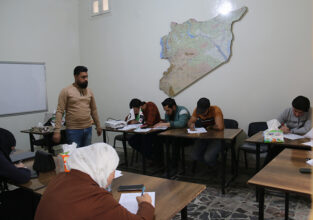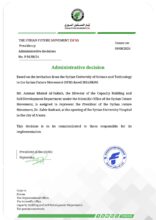The Religious Factor in Human Conflict: Syria and Palestine as Examples

Introduction:
It can be argued that even wars described as religious are fundamentally secular at their core! Or more precisely: they have an economic, social, political, geographic, or other dimension. A simple examination of human history shows that religion has been an integral part of human imagination. Even if human conflicts are intertwined with ethnic, geographical, economic, and other factors, it is imperative not to deny the religious factor at the heart of the conflict. Perhaps wars that took on a religious color after the journey of Dhul-Qarnayn mainly originated from the Abrahamic religions “Judaism, Christianity, Islam”, of course without overlooking other ancient religions, such as “Zoroastrianism”, and contemporary ones like “Hinduism”, “Zoroastrianism”, and “Confucianism”. This is what we will attempt to clarify in this study from the Research and Studies Department of the Scientific Office for the Syrian Future Movement.
For instance, the Himyarite, who were pagans and converted to Judaism in AD 425, became a kingdom that persecuted Christians. In AD 531, they were invaded by the Christian Ethiopian forces, which were bolstered by the Byzantine emperor in Constantinople. This example can be considered as a clear representation of the influence of the religious factor in shaping and directing human conflict.
In this study, we will use two contemporary examples to demonstrate the ongoing impact of the religious factor in conflicts. The first is the Syrian case, which we will delve into more deeply since it concerns us as Syrians. The second example is the Palestinian one, especially topical after the earthquake of October 7 and the painful repercussions that shook every Arab, Muslim, and indeed every human being. This study aims to depict the reality and highlight a problem that is long overdue for a solution.
The Religious Factor in Modern Syrian Conflict:
In our modern era, we see the influence of religion on the Syrian conflict. After gaining independence from the French occupation, the question of the time was about Islam’s stance on socialism and capitalism. Therefore, bulletins were issued in Al-Manar magazine affiliated with the Syrian Muslim Brotherhood group. Dr. Mustafa Al-Siba’i wrote the book “The Socialism of Islam”. Broadly speaking, Islamic currents in Syria, when they first emerged, were affiliated with the Muslim Brotherhood. This group can be considered as the mainstay of Syrian Islamic activist thought in the 1940s and 1950s. However, the conflict began in the 1960s within the Brotherhood itself over the issue of armed jihad, between the group of “Issam Al-Attar” and the group of “Saeed Hawwa” (1409H – 1989AD) and “Adnan Saad al-Din” (1431H – 2010AD).
Since the Ba’ath Party took power in Syria and the Muslim Brotherhood was excluded from it, and they accused the Ba’ath Party of being anti-Islam, the schism became evident. Religion clearly influenced and directed an intra-Syrian conflict, manifested in several key areas, notably:
– The principle of “Hakimiyyah” or, in other words, the application of Islamic Shariah, considering the ruling regime in Syria as a secular, heretic Alawite, and believing that it is obligatory to fight against it and overthrow it. This called for the need to seize power and implement Shariah. This proposal had a profound impact on shaking the concept of national statehood. This was evident in the significant debate over the application of the Unified Arab Law. After the establishment of the Unified Judiciary Council in Aleppo in 2012, many disagreements occurred until the Unified Arab Law was finally adopted. The “Sharia Court in Aleppo and its Countryside” adopted this law in criminal and civil procedures and announced its application starting from October 12, 2015. “Dar Al-Adl” in Hauran also adopted the Unified Arab Law as a general reference for its judiciary in November 2015 after consulting many scholars, with the most notable being the “Syrian Islamic Council”, which called for the adoption of the Unified Arab Law as the basis for Islamic courts in Syria. The judicial body of the “Ahrar al-Sham” movement announced on June 18, 2017, the adoption of the Unified Arab Law in all its courts in Syria, which it had long rejected when the Unified Judiciary Council in Aleppo chose it.
On the opposite side of power, we see that religion was one of the significant factors in stabilizing the authority of the Syrian regime and preventing any uprising against it as follows:
1- Sunni Islam: The Syrian regime built its religious narrative through the Sunni religious leadership, considering it as belonging to the Ash’ari Sufi school of thought. Therefore, this school believes in the necessity of listening and obeying any ruler unless blatant disbelief is observed from him. Generally, the Syrian Sunni leadership distinguishes historically between the people of governance and politics on one hand, and religious figures on the other. Both should unite, so the scholars and religious figures do not have a role in political practices. Their role is limited to spiritual education. As for political jurisprudence, it is considered vague due to the exceptions the Ummah (Muslim community) has been through, especially since the conflict between Ali and Muawiya. Therefore, reality and benefit are the bases, in addition to the calls to control one’s desires through remembrance and piety and sticking to scholars (who are fundamentally produced by the power institutions). The best representation of this narrative is the Sufi orders, like the group of Ahmad Kaftaro (1425 AH – 2004 AD) and Mohammad Said Ramadan Al-Bouti (1434 AH – 2013 AD), and the Qubaisiat group.
2- Minorities: The Syrian regime left a controlled and monitored margin for Salafi movements internally, especially in the rural areas. With the outbreak of the Syrian revolution, Salafi movements managed to break free from the regime’s security grip, giving them more space to express their known traditional Salafi discourse. The Syrian regime cleverly utilized this, emphasizing the fears of minorities, securing their loyalty and support, and creating a significant base. This allowed the regime to focus on eliminating its opponents and adversaries. For instance, many from the Alawite community, since the beginning of the Syrian revolution (regardless of their political stance), showed a clear lack of sympathy with the victims of their homeland killed by the Syrian regime. Many displayed fears of mosques and anything that originates from them. Many showed clear cooperation with security and military agencies in suppressing the Syrian revolution in all its peaceful and violent forms. Many also actively participated in “Shabiha” groups and the “National Defense Army” later on, in addition to their continued enrollment in the army as mandatory service, reserve, or volunteers.
From this narrative, religion can be considered a significant factor in the internal Syrian scene, taking into account other factors that led us to our current situation.”
The Religious Factor in the Palestinian-Israeli Conflict:
In his diaries, “Herzl” lists the reasons he sees “Argentina” as an alternative homeland for the Jews who were not exterminated in Hitler’s Holocaust. However, the Jewish religious factor was adamant about Palestine. In Palestine is the alleged Temple of Solomon, and Christian Zionism believes that the return of the Messiah necessitates the gathering of Jews in Jerusalem. Thus, Palestine was chosen over Argentina.
Religion can be considered influential in the Palestinian arena between two axes:
The Jewish Axis:
– Jews in the Talmud and Torah sanctify King David who made his capital in Jerusalem “Al-Quds.” Jews also consider the Wailing Wall or Western Wall (Al-Buraq), which is located below the courtyard of Al-Aqsa Mosque, the last remnants of the Jewish Temple (the Temple) that was destroyed by the Romans in 70 ADS, as their holiest place. Jews claim that Jerusalem has been their historical capital for 3,000 years for both religious and political reasons. According to Jewish heritage, besides the temple being there, Jerusalem was the capital of the historical Kingdom of Israel ruled by King David in the 10th century BC, and later for the Jewish Hasmonean Kingdom.
The Palestinian Axis:
Advocates for the application of Sharia are a minority among Palestinians, who are divided between secular leftists or nationalists who see Palestine as their country and believe in resisting occupation according to international laws. On the other hand, there are Islamists whose main concern is the Jihad against the occupiers of their land, especially under what’s termed as “defensive Jihad”, especially since the Al-Aqsa Mosque is sacred to Muslims. Therefore, the religious Jihad should be declared.
Through this brief narrative, we objectively see that both Palestinians and Jews associate religion with the land. Consequently, we are witnessing a clash of two contradictory religious narratives that have influenced reality as a whole, and the bloody Palestinian-Israeli conflict! Between a narrative that speaks of Jewish entitlement to Palestine and another that says Jews are occupiers who must be resisted, and that the land belongs to the Palestinians.
Conclusion:
No matter how some try to downplay the role of religion in influencing reality, we see it as a powerful driver shaping conflicts that have persisted for years, be it in Syria or Palestine! Religion plays an important role in making immense sacrifices to protect land and honor, not to mention faith and belief! Perhaps this is what we see today in the steadfastness of the people of Gaza in their homes, for example, despite the great sacrifices they make, and the continuation of the revolutionaries in Syria in confronting the Syrian regime until its rule is toppled.
We also see the influence of the Torah’s description of non-Jews as beasts and animals and the resulting reprehensible behaviors. On the other hand, the texts of the prophetic tradition, which call for Muslims to fight Jews until the last breath, behind every stone and tree, are considered the main driver and dynamo for all the developments on the ground!
Here comes the question, can religion alone ignite conflicts among humans?! And if so, what is the solution? Is the solution to fight religion? This is difficult because religion in its essence is a personal individual choice despite the influence of the environment and society.
Perhaps the only solution is to search for opposing or harmonious religious narratives, either as alternatives to violent narratives or to neutralize their acidity. Thus, we face several scenarios:
– Not involving religion in conflicts and relying on other factors such as politics, society, secular alliances, and human rights.
– Opposing violent religion.
– Supporting non-violent religious narratives that de-legitimize violent narratives.
Therefore, according to the vision and approach of the Syrian Future Movement, we advise the rationalists as follows:
1- Avoiding excessive denigration and opposition to religions, as it will only trigger an adverse reaction and will not result in commendable outcomes.
2- Recognizing the human condition that extremism is met with opposite extremism, and that extremism feeds on its counterpart. For example, devout Syrians would not have taken up arms if there wasn’t sectarian violence by the Alawite Syrian regime, and Hamas might not have rejected the two-state solution if Israel had accepted the Arab League initiative, and so on.
3- Paying attention to mobilizing moderate voices from all sides, focusing on moderate religious leaders who reject violence from the outset and who approach their religions with a humanitarian eye rather than an ethnocentric one. Only they can reform the religious factor to influence a civilized human dialogue rather than a bloody, exclusionary conflict.
4- It’s essential to diminish the role of all religious extremists, not just diminish one religion at the expense of another, or to combat a reaction instead of the action itself! Without such a holistic approach, success won’t be strategically sustainable.
Juma Mohamed Laheeb
Researcher in the Research and Studies Department
Religious office
Syrian Future Movement (SFM)






